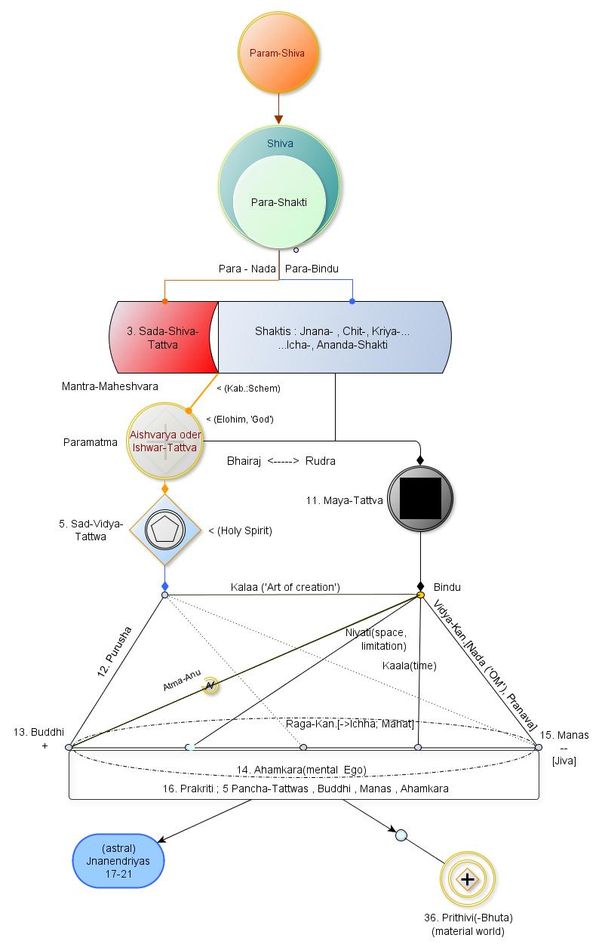The Atman
"The Atman is the light of the divine; the world is under the control of the Atman", Sri Aurobindo
" In all created was HE the life, and for the people he was the light. The light shines into the darkness and the darkness could not expunge it." (Gospel of John 1, 1-5)
The Nṛisiṅha-uttara-tâpanîya-Upanishad(Nṛisiṅhapûrvatâpanîyâ) [ 1. ] of the Atharva-Veda sees the Atman with the Om-Sound equal to the Brahman as a cosmisc priciple.
This view is inspiredby the basic idea that the Atman only in his highest sixteenth aspect as a subject of knowledge (avikalpa) persists in all its purity. It projects with fifteen subordinate shapes into the world and conditions, the reality and also reality of the the fifteen subordinate forms, which are seen void from the highest standpoint.
Advaita denominates the individual souls as Jīvātman. The highest Brahman of the Trimurti is here the Paramātman.
The individual Atman(Jivatma) unites from the sight of the Vaishnavas finally with Krishna who is uplifted as the divine Paramatma, which is also a divine body of the enlightened yogin.
"Know the Atman as the Lord of the carriage. The body is the car, the buddhi (reason) is the charioteer and the mind is the reins. The senses are the horses, the objects the ways." (Katha-Upanishade II.3–4)
This is my inner Atman in the inner heart, smaller than grain of rice or barley or millet grain or millet grain core ..... The all - acting, all - wishing, all - smelling, all - tasting, , concluding this universe in itself, wordless, careless, he is my inner soul in the heart, he is the Brahman to which I will go depositing from here. (Chandogya Upanishad, die ŚĀNDILYA - Lehre : 3.14)
|
He is the light-energy of and beyond the "Ishvara-Tattwa", which emanates Sad-Vidya or the "Holy spirit" of the christian bible, the kabbalistic "flash" of the Sephiroth. Kashmir-Shivaism knows thirty-six principles or Tattwas which are divided into three majorgroups which go by the name of Chit, Chit-achit and Achit or pure, pure-impure and impure. 1. The first group includes the first five principles namely, Shiva, Shakti, Sadashiva, Ishvara(with the Param-Atma) and Sadvidya, which contains the Atman. 2. The second group contains the next seven principles: Maya, Kaala, Niyati, Raga, Vidya, Kalaa and Purusha. 3. The last group contains the remaining twenty-four principles namely, Prakriti, Mahat, Ahamkara, five Tanmattras, Manas, five organs of knowledge, five organs of action and five elements (mental Plane 4) |
Worldview of kashmir shaivism
 |
Hinduism describes the creation as LILA , the interaction of Purusha and Prakriti.
The forces of the buddhic plane are created when Atman interacts with the Maya-Tattwa and causes vibrations - the Anu and the buddhic pranava - the lower Brahman.
The Purusha is an individual Atman.
"The Atman creates illusionary forms in the Maya"(Atma-Puja).
15. In its identification with the five-sheaths the immaculate Atman appears to have borrowed their qualities upon itself - like a crystal which appears to gather unto itself colour of its vicinity (blue cloth, etc.,) (Shankara - Atma Bodha 15)
On the mental plane the influence of the "Kanchukas" causes another polarity - of buddhi and manas, the negative pole, the mental mind. Here has the influence of the SELF caused a reverse creation, an individual shell, which is the basis of the evil forces (hinduistic Asuras) in this plane. Here is the Purusha an individual Atman.
== Literature ==
Adi Shankara :
- Viveka Chudmani( Palladium of wisdom ) : Teachings about the SELF
- Atma Bodha : Knowledge of the Self
- Tattwa Bodha : The elements of creation
== Weblinks ==
- About the Bindu
- A Wiki about Atman
- A Wiki about Kanchukas
- Newworldencyclopedia about the Atman
- Shankara : Atma-Atma Bodha
of Spirituality
universal-path.org